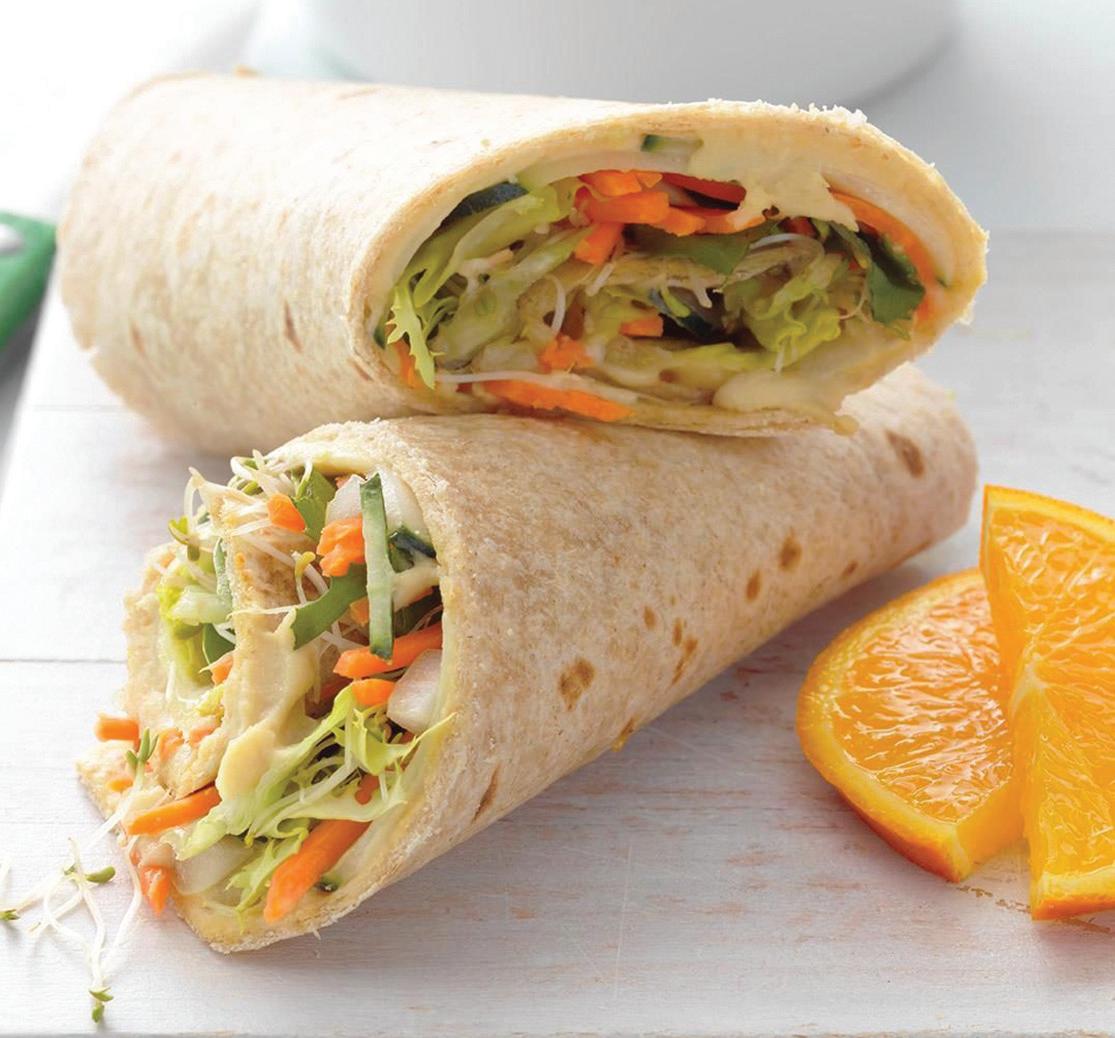
7 minute read
TRYTHISDISH
by Kim Beavers, MS, RDN, CDCES
Mediterranean Veggie Wrap
This recipe can be for lunch or dinner, but it also makes a “worth waking-up for” breakfast. Leftovers for breakfast is a great way to add veggies to breakfast, and this wrap makes running out the door with health in mind deliciously simple. This recipe also works stuffed into a pita round.

Ingredients
Roasted Vegetables
• 1 pint grape tomatoes, halved
• 1 medium zucchini, chopped into 1/4-inch pieces
• 1/2 medium sweet onion, diced

• 1/2 teaspoon Italian seasoning

• 1 teaspoon extra-virgin olive oil
Wrap
• 4 whole grain wraps (most are lower carbohydrate)
• 1 cup spinach
• 1 cup pre-made hummus of your choice
• 1/4 cup roasted red pepper
• 1 cup of roasted veggies
Directions
Preheat the oven to 350° and line a sheet pan with aluminum foil. Spread the tomatoes, zucchini, and onion out in a single layer on the pan; sprinkle with seasoning and drizzle with oil. Toss the veggies with your hands to coat with oil. Roast for 20 to 30 minutes, turning the veggies about halfway through cooking time.
Once the veggies are done you can build your wrap (or pita). First, spread 1/4 cup of the hummus evenly over the middle of a warm wrap. Then line the hummus with spinach leaves (1/4 cup).
Next place one-fourth cup veggies and one tablespoon roasted red pepper on the spinach and fold the wrap “burrito” style. (How to: take the edge of the wrap closest to you and fold it over the fillings, then press down and pull back, thus dragging the fillings a bit closer towards you. Next fold in each side, and finally tightly roll the wrap all the way up into a tight roll. The burrito fold will make it easy to eat on the go.) The remaining wraps can be stored in the refrigerator to “grab-and-go” when needed.
Yield: 4 Servings
Nutrition Breakdown: Calories 250, Fat 10g, (0g saturated fat), Cholesterol 0mg, Sodium 600mg, Carbohydrate 39g, Fiber 19g, Protein 15g.


Percent Daily Values: 20% Vitamin A, 45% Vitamin C, 15% Calcium, 20% Iron Diabetes Exchange Values: 2 Vegetables, 2 Carbohydrates, 1 Protein, 1Fats

Kim’s note: Tortillas will fold more easily if you warm them briefly in the microwave (20 seconds or so). Also note, you will likely have more vegetables than needed for this recipe, they can easily be folded into scrambled eggs, used as a toast topper, bake potato filler, or grits topper. Enjoy!
Simone, a student at Augusta University, asks:
“Dr.
Simone, thanks for the question. It is a bit different from the nutrition questions I usually answer in this column, but I thought my readers might be interested in the answer. Where does a nutrition research scientist begin? The very first step is formulating and defining a research question. A scientist is trained to question just about everything. The key and the challenges are asking the right questions. So, that is where your research project should begin, with the question.

When I peer-review research papers for medical journals, sometimes I am surprised by what I read. For example, sometimes I find that the experimental design is not the design that should have been used by the researchers to adequately answer their research question. The first thing to do if you want to do nutrition research is to ask the important questions. The next thing is to make sure your research design will answer the question. Also, make sure you have the required education, skills and tools needed to answer the question. You do not want to focus on a question that is beyond your ability or outside the resources that are available to you.
One problem I find is that researchers start out to answer one question, but their data and conclusions answer an entirely different question. Sometimes the question they end up answering may be more important than the original question. Is that a good situation? Seems like it should be. The problem is that the scientists may be unaware of what their data shows. How does this happen? The researchers are so focused on fitting their data into an answer to the original research question, they don’t realize that they have stumbled upon a more important answer to a more important question. Unexpected data should excite you. It may give you a reason to think in a whole new direction and ask questions you had never even considered before.
You also need to be an enthusiastic lifelong learner. You cannot ask the right question unless you know what is “known,” what is “not known” and what “needs to be known.” The “known” is extremely comfortable. The “unknown” is much less comfortable, although more exciting. Be sure your knowledge is complete about what is known in your proposed research area and then figure out what are the most important pieces of information that still need to be known. Throughout your research project, you need to constantly review new data that is being published in your area and then “tweak” your question, considering the new information.
How skilled are you at teasing out a smaller, specific answerable question from a broader question? In other words, how good are you at focusing broad research questions into narrower, answerable, specific questions?
You need to develop the skill to narrow down a question so that, finally, you arrive at a question that is answerable by you, with your own specific skill sets.
Your goal is to advance nutrition science by contributing an important packet of information. You need to take one small step for humankind, not a giant leap. Do not expect your research project to result in The Nobel Prize. The key to successful scientific research is your wisdom to formulate small, answerable, important questions that are answerable within your expertise, training, and the research tools available to you.

What is the “No-Nonsense Nutrition” advice for today?
If you are thinking about beginning nutrition research, asking the right question is the place to begin. The key is formulating a specific, answerable question and continually evaluating and re-evaluating your question in view of the evolving data and knowledge in the area. Good luck in your nutrition research career and thank for the interesting and unusual question. Beyond that, Simone, I also hope that my answer has given readers some insight into how evidenced-based nutrition research projects begin.
Have a question about food, diet or nutrition? Post or private message your question on Facebook (www.Facebook.com/ AskDrKarp) or email your question to askdrkarp@gmail.com If your question is chosen for a column, your name will be changed to insure your privacy. Warren B. Karp, Ph.D., D.M.D., is Professor Emeritus at Augusta University. He has served as Director of the Nutrition Consult Service at the Dental College of Georgia and is past Vice Chair of the Columbia County Board of Health. You can find out more about Dr. Karp and the download site for the public domain eBook, Nutrition for Smarties, at www.wbkarp.com Dr. Karp obtains no funding for writing his columns, articles, or books, and has no financial or other interests in any food, book, nutrition product or company. His interest is only in providing freely available, evidenced-based, scientific nutrition knowledge and education. The information is for educational use only; it is not meant to be used to diagnose, manage or treat any patient or client. Although Dr. Karp is a Professor Emeritus at Augusta University, the views and opinions expressed here are his and his alone and do not reflect the views and opinions of Augusta University or anyone else.


Dr. Karp


Tasty tips from registered dietitians with the Augusta Dietetic District Association

Osteoporosis and a Bone-Friendly Lifestyle
by Janice Anglin, MS, RDN, CSG Clinical Dietitian Board Certified Specialist in Gerontological Nutrition
VA Augusta Healthcare
System-Uptown Division
The National Institutes of Health (NIH) defines osteoporosis as a bone disease that develops when bone mineral density and bone mass decreases, or when the structure and strength of bone changes.¹ Osteoporosis, meaning “porous bone,” is a disease that weakens bones, often developing without symptoms or pain, yet it increases the risk for sudden and or unexpected bone fractures.

According to the National Osteoporosis Foundation, approximately 10 million Americans have osteoporosis and another 44 million have low bone density. Half of all women and up to one in four men will break a bone in their lifetime due to osteoporosis.² Osteoporosis can occur at any age, but the risk increases as we age.
There are several ways to diagnose osteoporosis. The U.S. Preventive Services Task Force recommends testing for all adults with a condition
(e.g. rheumatoid arthritis) or who take a medication associated with low bone mass or bone loss (e.g., glucocorticoids), men and women age 50-plus with a fracture; women age 65-plus, and men 70 and above, regardless of clinical risk factors.
While there are many non-modifiable risk factors like sex, age, race, family history, hormone changes, and other medical conditions, there are several modifiable risk factors. They include diet, medications, smoking cessation, avoiding chronic alcohol consumption, eliminating a sedentary lifestyle, and others.
Good nutrition is critical to bone health. The key macronutrient for bone health is protein. Vitamin D and calcium are vital micronutrients for normal bone mineralization.
The Recommended Dietary Allowance (RDA) to prevent protein deficiency for an average sedentary adult is 0.8 grams per kg of body weight. However, recent research has shown older adults (above 65 years) require 1 to 1.2 grams of protein per kg of body weight.3,4 Protein consumption should be spread
GOOD SOURCES OF PROTEIN
Food Source Serving Size Protein Grams
Beef 3 ounces
Salmon 3 ounces
Chicken 3 ounces
Lentils (cooked) 1 cup
Almonds 0.3 cup
Researchers recommend that older adults consume 1-1.2 grams of protein each day for every 2.2 lbs of body weight. Example: for someone who weighs 110 pounds, the recommended daily protein intake is 50 to 60 grams. + throughout the day with 25-30 grams recommended at each meal.4

The RDA for calcium is 1,000 mg for men 19-70 years, and 1,200 mg for men 71 and older; for women aged 19-50 years it’s 1,000 mg, and 1,200 mg for women 51 and above. The RDA for vitamin D for men and women 19-70 years is 15 mcg (600 IU) and over 70 years, 20 mcg (800 IU) daily. 1,2,5
Exercise has been shown to increase bone mineral density and decrease fracture risk. Weight-bearing exercise increases bone density at the spine and hip. Exercise programs that include balance, strength and endurance training significantly reduce the risk of falls and associated fractures. By combining resistance and weight bearing exercises you can obtain the most benefit to increase bone strength.2
Bone healthy living includes regular exercise and adequate nutrition focusing on protein, calcium, and vitamin D to aid in posture, balance and reducing the risk of fractures and disease.
For more information:
• americanbonehealth.org/online-osteoporosis-community/ • bonehealthandosteoporosis.org/ patients/patient-support/faq/
References:
• 1. niams.nih.gov/health-topics/osteoporosis#:~:text=Osteoporosis%20 is%20a%20bone%20disease,of%20 fractures%20(broken%20bones).
• 2. https://www.bonehealthandosteoporosis.org/wp-content/ uploads/2015/12/Osteoporosis-Fast-Facts.pdf
• 3. acl.gov/sites/default/files/nutrition/Nutrition-Needs_Protein_FINAL-2.18.20_508.pdf
• 4. Protein Intake and Frailty: A Matter of Quantity, Quality, and Timing - PMC (nih.gov)
• 5. Nutrient Recommendations and Databases (nih.gov)










